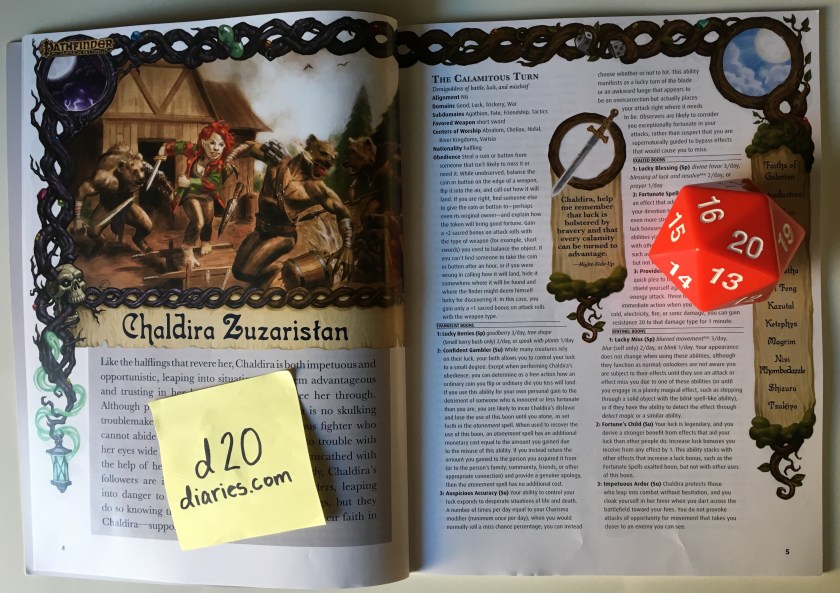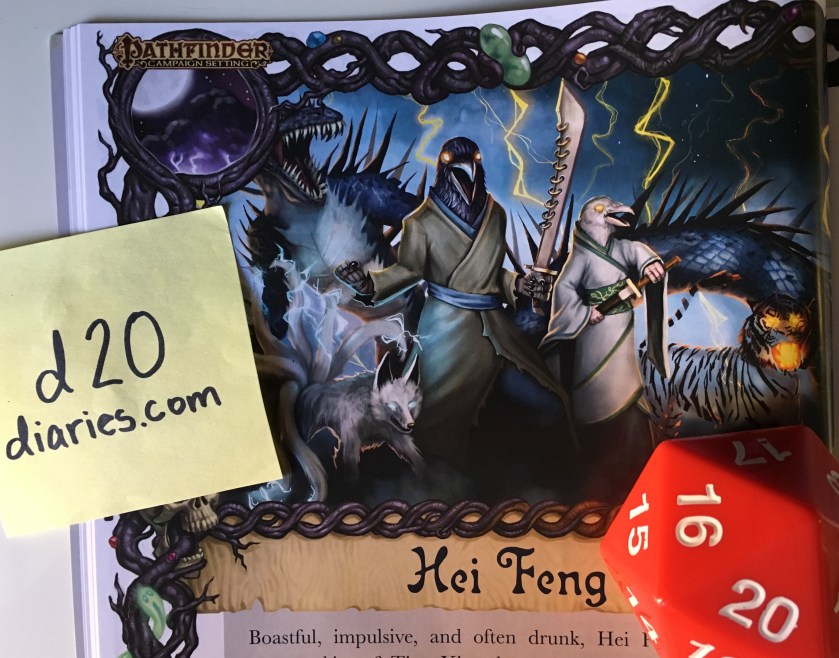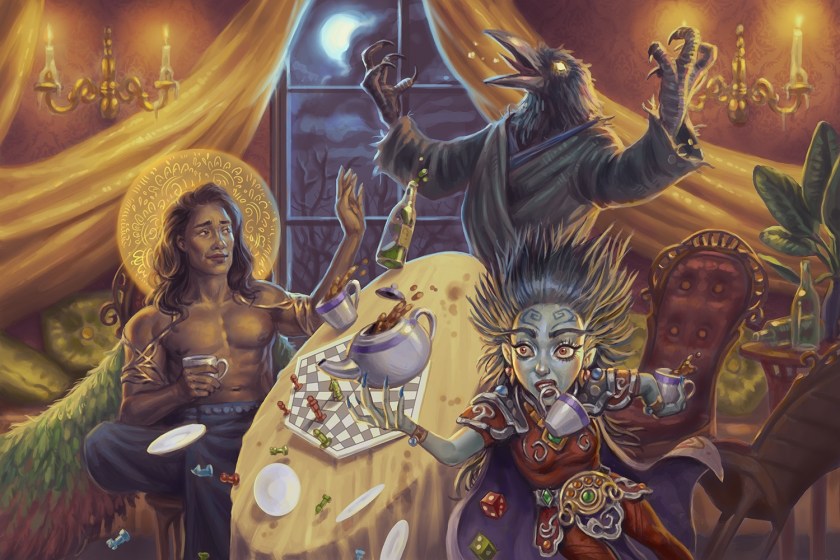 Hey everyone! Thanks for stopping by. Today we’re taking a look between the the covers of the latest ‘gods’ book: Pathfinder Campaign Setting: Faiths of Golarion! Although I’ll be mentioning what’s in this book and talking about my favourite parts, this is not meant to replace the book itself. The opposite, in fact! It’s meant to let you know what’s inside so you can decide for yourself whether this is a book that will be of use to you. For me? Definitely! Curious what’s inside? Read on!
Hey everyone! Thanks for stopping by. Today we’re taking a look between the the covers of the latest ‘gods’ book: Pathfinder Campaign Setting: Faiths of Golarion! Although I’ll be mentioning what’s in this book and talking about my favourite parts, this is not meant to replace the book itself. The opposite, in fact! It’s meant to let you know what’s inside so you can decide for yourself whether this is a book that will be of use to you. For me? Definitely! Curious what’s inside? Read on!
Featuring cover art by Igor Grechanyi that showcases the gods Gruhastha, Hei Feng, and Nivi Rhombodazzle, this soft cover book is 64 pages in length. Other contributing artists include Gislaine Avila, Emanuele Desiati, Vlada Hladkova, Sandra Posada, Luca Sotgiu, and Vicky Yarova. Contributing authors include Kate Baker, John Compton, Adam Daigle, Crystal Frasier, Ron Lundeen, Liane Merciel, Michael Sayre, and Owen K.C. Stephens.
Like the many god and faith themed books before it, this book takes an up close look at a variety of faiths, talking about the gods and goddesses, their faith, church, priests, worshippers, holy texts, holidays, aphorisms, planar allies, and so on. It also features information on their alignment, domains, subdomains, favoured weapons, centres of worship, paladin and anitpaladin codes (if there is one), obediences, and boons (usable by those who take the deific obedience feat, or take levels in the exalted, evangelist, or sentinel prestige classes from Inner Sea Gods). There’s plenty of awesome art in this book, with each faith discussed having four images: one of the deity, one of the holy symbol, one of a worshipper, and one action shot of the deity.
 There are ten faiths discussed in this book. Each is a lesser detailed but very important faith. This includes a few racial faiths — the halfling goddess Chaldira Zuzaristan, the gnome goddess Nivi Rhombodazzle, the elf god Ketephys, and the dwarf god Magrim. It also includes information on deities from other regions of Golarion such as the Tien gods Hei Feng, Shizuru, and Tsukiyo, as well as the anadi goddess Grandmother Spider who is popular in the Shackles and Sodden Lands, the Vudrani god Gruhastha who is popular in Vudra, and the Razatlani goddess Kazutal who is popular in Arcadia. Each of these faiths is incredibly important to their respective cultures and I’m thrilled to see them get some of the attention they deserve. Information on the racial deities, especially, I feel was long overdue. Before sitting down to read this book I was most excited for further information on Ketephys, Shizuru, and Tsukiyo. All of the entries were great, but after reading I was most inspired to make worshippers of Grandmother Spider, Kazutal, and Tsukiyo.
There are ten faiths discussed in this book. Each is a lesser detailed but very important faith. This includes a few racial faiths — the halfling goddess Chaldira Zuzaristan, the gnome goddess Nivi Rhombodazzle, the elf god Ketephys, and the dwarf god Magrim. It also includes information on deities from other regions of Golarion such as the Tien gods Hei Feng, Shizuru, and Tsukiyo, as well as the anadi goddess Grandmother Spider who is popular in the Shackles and Sodden Lands, the Vudrani god Gruhastha who is popular in Vudra, and the Razatlani goddess Kazutal who is popular in Arcadia. Each of these faiths is incredibly important to their respective cultures and I’m thrilled to see them get some of the attention they deserve. Information on the racial deities, especially, I feel was long overdue. Before sitting down to read this book I was most excited for further information on Ketephys, Shizuru, and Tsukiyo. All of the entries were great, but after reading I was most inspired to make worshippers of Grandmother Spider, Kazutal, and Tsukiyo.
So who, exactly, are these deities?
So glad you asked!
Chaldira Zuzaristan is a brash and reckless halfling demigoddess of battle, luck, and mischief. She fights against oppressors, tyrants, and injustice, trusting in her luck and companions to see her through. A bit of a thieving troublemaker, but not malicious, Chaldira is good friends with the goddess Desna, who shares her love of travel. One of my favourite parts of the article on Chaldira is her eccentric planar allies, particularly her herald The Button Fellow.

Grandmother Spider is a cunning goddess of twilight, illusions, family, and weaving. Created by the gods as a tool be used alongside her brother, Achaekek, Grandmother Spider was tasked with weaving the world and the destiny of the mortals in it. But she rebelled against the gods and wove a new destiny for herself, granting herself free will and divinity. She’s a trickster, teacher, and folk hero. I particularly enjoyed reading about her relationships with the other gods — she once stole Asmodeus’ keys and enjoys teasing her brother Achaekek. Who doesn’t want to irritate the assassin of the gods?! Haha. I also adore all the art in this section!
Gruhastha is the vudrani god of peace, understanding, and self-improvement. Once Irori’s nephew he sought to record his knowledge for the world. Upon completing his perfect book, the Azvadeva Pujila, he became the divine embodiment of that holy text. Now Gruhasta seeks to enlighten the world so that one day it will be so perfect it becomes one with Nirvana. Interesting!
Hei Feng is a wild and unpredictable tengu god who is very popular in Tian Xia. A moody god of the sea, storms, thunder, and wind, he is always accompanied by his four companions, the Counts of Lightning, Rain, Thunder, and Wind. Drunken, boisterous, and easily angered, Hei Feng is a dangerous deity. As one of the most popular Tian gods I’m happy to see he got some attention. Turned out Hei Feng is my son’s favourite god in the book.

Kazutal is a deity I didn’t know much about, but wow! She is awesome! Haha. Also known as Mother Jaguar, she’s a war goddess whose focus changed over the Age of Darkness, when community and togetherness became integral for survival. Now a goddess of war, family, togetherness, community, liberty, and safety, she promotes a love of your neighbours, family, and friends. This love should be spoken of plainly and without shame, for its these bonds of love that cause neighbours to have the courage to stand up and protect one another. It’s love that makes communities strong. Those who don’t show love of others are considered cowards. Which is awesome! I really enjoyed reading about her faith’s take on love, and the evolution of her religion. I also adore the art in this section! It’s amazing!
Ketephys is the calm, stoic elven god of hunting, the moon, and the forest. He’s a god of archery, and urges his followers to respect nature, replace what they take, and never waste. This is one of the gods I was most excited to see included in Faiths of Golarion, as the elven deities were among those created back when Pathfinder didn’t have it’s own rules, and I feel like I’ve been waiting forever for further details on them. There are some details, of course. A paragraph or two throughout the various Paizo products, but I wanted more. I would have been happy to see details on any of them, but I’m particularly pleased to see its Ketephys.

Magrim is another deity that’s been around since the beginning of Pathfinder but lacked much information. The dwarven god of death, fate, tradition, and the underworld, he’s fair, unflinching, and unwavering. Magrim considers Pharasma a respected elder, and is often tasked by her to repair damaged spirits that enter the Boneyard. I really enjoyed learning how Magrim fit alongside Pharasma, and his role in the dwarven afterlife.
Nivi Rhombodazzle is about as different as Magrim as you can get. This gnome gambler fled underground to escape her many angry creditors and ended up becoming the first of the svirfneblin after she traded a rare gem to Torag in exchange for divinity. Talk about a deal! Nivi’s an impulsive daredevil addicted to the thrill of a wager. She urges others to test their skill, push their luck, and experience the best life has to offer. And when luck turns against you and you’re in a lot of debt? Run, of course! Best of luck! Haha. She’s a tricky, thieving little thing whose faith is said to hold the key to staving off the Bleaching.

Shizuru is another of the gods I was most interested in reading about. This draconic Tien goddess is also known as the Empress of Heaven, and is the main deity of the Tien pantheon. A goddess of honour, swordplay, the sun, and ones ancestors, she’s incredibly popular among the people of Tian Xia and players of Pathfinder. I particularly enjoyed reading about her relationship with Tsukiyo, her lover who died and came back to life changed.
Which brings us to Tsukiyo, the final deity in Faiths of Golarion. Killed by his own jealous brother, Tsukiyo was the beloved of Shizuru. But his lover couldn’t accept his death and she ordered Qi Zhong, god of medicine and healing, to bring his back to life. It worked, but Tsukiyo came back changed. Now quiet, contemplative, and possessing an uncommon outlook, he is god of the moon, spirits, and outsiders. He teaches that no matter a person’s perceived flaws and oddities, all are a whole person deserving of respect. This applies to those society shuns, deems insane, are disabled, or those suffering from mental illness. I absolutely love what they did with Tsukiyo. Delightful from start to finish.
Which brings us to the end of Pathfinder Campaign Setting: Faiths of Golarion! If you’re a fan of learning about the many deities of Golarion (like I am) I highly recommend picking up this book!
Enjoy!
Jessica









